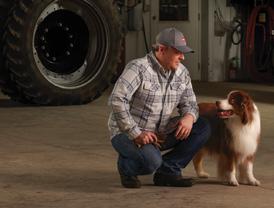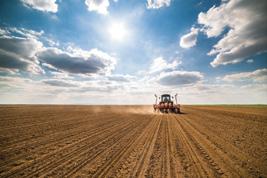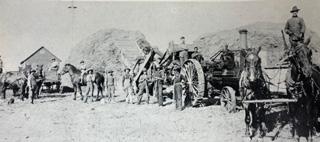
5 minute read
Coop Gas & Oil
LIVE AND LEARN
Except for a part-time truck driver in the fall, the work on both the livestock and crop side is all in the family. Todd said, “I feel fortunate that both Alex and Austin had jobs waiting for them before they graduated” and that the employers give them the flexibility to help on the farm. “Without these two guys, I can’t run the acres I run,” Todd said. Alex brings technology and mechanical skills to the crop side of the operation. Austin lives on the site of the nursery, so it’s natural he helps with the pigs. Their dad said, “They also know how to do each other’s jobs. And harvest is the big time when it’s all hands on deck.”
Advertisement
The sons have begun to directly rent cropland of their own. Todd said, “Their ground, my equipment. You sit in the seat, you plant your own stuff. When you mess up planting, you get to learn in hurry.” Not long after Alex graduated from college, Todd said, “He planted some acres and I ended up spraying it. I came back and told him I wasn’t combining it. He went to combine later and said, ‘Yep, not doing it that way again.’” Alex and Austin have learned from some of those mistakes. Fortunately, “Mom and Dad taught us how to work hard; and how to have fun,” Austin said. The family values the rural area and being able to know their neighbors. “You go to the local café, you talk more than you eat,” Todd said. Tammy’s life goal is to get the right mix of family and farming, while always keeping the faith.
Alex and Maria Popken with their daughter, Denali. Photo courtesy Alex Popken.

Austin and Nicole Popken. Photo courtesy Austin Popken.
DOWNTIME YOU CAN ACTUALLY ENJOY.
AHEAD OF SCHEDULE.
POWERED LOCALLY. ®

Getting out of the field ahead of schedule gives you more of the good kind of downtime. Downtime that comes after a job well done. Give your ag equipment an added boost with the powerful combination of Cenex® Ruby Fieldmaster® and Cenex premium diesel engine oils. Together, these products help extend the life of your engines, injectors and injector pumps to reduce breakdowns and costly repairs. And you can count on the Cenex® brand to stand behind its products with the best warranty in the industry, Cenex Total Protection Plan®, that keeps you running, for up to 10 years or 10,000 hours.
From Lubricants to Premium fuels to the service your equipment and vehicle needs to keep you going is just the beginning of what your Coop Gas & Oil can do for you! PROPANE
We off er both propane and propane service.

TIRES
Providing the most respected names in tires and on-farm tire service.
HIGH TIMES AND HARD TIMES IN EARLY LARCHWOOD
The first white man settled in the Larchwood area in 1869. Early settlers in Lyon County were plagued by many problems: Drought in 1871, grasshoppers in 1873 and other years, diphtheria, and blizzards in 1881 and 1888.
The problem of obtaining supplies was particularly difficult as lumber and building materials had to be hauled from Le Mars, Sioux City or Sibley. In turn, grain was hauled to shipping points by oxen team and wagon. Reports said grain caravans were as long as two miles. The Larchwood land tract was first held by Charles W. Holder of Bloomington, Ill., beginning in 1869. The town of Larchwood recognizes 1872 as the its real launch point. In 1873, Holder sold his land grant to Jesse Fell for $1.25 an acre. Fell planted the European larch trees which would become the town’s namesake. Fell sold the land in 1881 to the Close Brothers who were headquartered in Le Mars. The Close Brothers were Englishmen active in land speculation and development. They sold the land later that same year to Richard Sykes of Manchester, England, for about $1 per acre. Sykes began the real development of the town. In the beginning, Sykes followed the model of the Close Brothers and retained ownership of much of the land – there was a company barn for implements and animals; and company houses on each of the 32 quarter sections.

Early scene on the Phillip Heyer farm, which Heyer purchased from Sykes Brothers.

Threshing crew on the Phillip Heyer farm.
S.B. Willard built the first house in what is now the town. His home served as a stop for the stagecoach and freight wagons on their way between Sibley and Sioux Falls. The first post office was also located there. By 1900, most farms in the Larchwood area were locally owned and so profits from farming stayed local. The first 30 years saw Larchwood grow rapidly as the farm area was settled. When the railroad was built through the town in 1886, Larchwood had a real spurt in growth of businesses, and the business district was moved from the old part of town, (west and north of the City Park), to its present location. The first local store was erected to serve the needs of the growing number of farmers by Rulland and Helgerson in 1874. The first postmaster was W.S. Willard and the first school was taught by P.J. Allbright in 1874. The first church service was in the school house in 1874 and was conducted by Rev. Palmer, a Congregational minister from Sheldon. The first wedding was in July of 1874, when William Friscius and Hanna Nelson were married. Larchwood was a sports town from its earliest beginnings. The late 1870s and most of the 1880s saw the young English bring racing horses and polo ponies to this area. In the area of Emerald Park, the race track was










